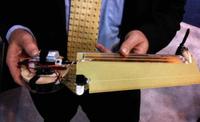-
New tool helps visualize post-event disaster environments
Using iPad mobile devices, emergency preparedness officials and first responders participating last month in the FEMA’s National Level Exercise 2011 (NLE-11), were able, for the first time, to make use of a new, science-based software tool that allows them to view and modify accurate models of building damage and other post-event disaster effects
-
-
Making rail travel more reliable
U.K. researchers are collaborating with industry to develop novel optical sensors that detect when overhead power lines are likely to fail; the costly disruption to rail travel caused by the breakdown of overhead power lines could thus become a thing of the past
-
-
DHS warns copper thefts on the rise

DHS officials warn that copper thefts from critical infrastructure and key resource sectors in the United States are on the rise; in March, a Port of Houston security guard was arrested for giving his friends and families access to the port, where they allegedly stole more than 22,000 pounds of copper
-
-
U.S., Canada to share hazard risk assessment software tool
Hazus, or “Hazards U.S.” is a risk assessment software tool for emergency management professionals that combines science, engineering, and geospatial information technology to estimate potential loss of life and property damage from disasters and natural hazards; FEMA is using it and now Canada will, too
-
-
Autonomous multi-target, multi-user tracking capability
An autonomous multi-sensor motion-tracking and interrogation system reduces the workload for analysts by automatically finding moving objects, then presenting high-resolution images of those objects with no human input
-
-
Lockheed Martin shows tiny surveillance UAV

The Samarai UAV is sixteen inches long and weighs less than half a pound; while flying, it can stream live video from a camera that rotated around its center providing a 360 degree view without a gimbal; it can be carried in a backpack and launchedt from the ground or like a boomerang
-
-
Cheap radiation detector made of PET resin developed
Researchers develop a revolutionary radiation-sensitive plastic with a performance superior to plastic scintillators used for measuring radiation; the discovery will enable a major reduction in production costs — a step toward an inexpensive radiation detector available to everyone
-
-
Day of "solar" soldiers nears

Researches develop wearable light-weight solar panels which will allow soldiers to generate power in the field and reduce the need for batteries for their electronic devices; they will also establish a power supply that keeps electronic devices operational throughout the duration of missions
-
-
Portable, super-high-resolution 3-D imaging
A simple new imaging system could help manufacturers inspect their products, forensics experts identify weapons, and doctors identify cancers.
-
-
Aussies to clone explosives sniffer dogs

Two Aussie dog-breeding companies will collaborate with South Korean scientists on cloning explosives and drug sniffer dogs; the first batch of ten dogs will go into service in 2013; the Australians cloned dogs would be made from tissue samples taken from a German shepherd called Hassan von Gruntal, who died in 2001; cloned sniffer dogs have already been used in South Korea and the United States
-
-
Software successfully predicted spread of West Nile virus in California
A computer model of the spread of West Nile virus was able to predict areas where human cases would be concentrated, especially around Sacramento in 2005; the success of the model, say researchers, depended on its focus on biological factors and on a high volume of reports from members of the public
-
-
New material dramatically increases explosive force of weapons

A revolutionary material that will replace steel in warhead casings will bring added lethality and increase the likelihood of a hit on an enemy target; by combining several metals with standard manufacturing techniques, High-Density Reactive Material (HDRM) has the potential dramatically to increase the explosive impact of most weapons with little or no compromise in strength or design
-
-
Reversing metabolism to make biofuels at breakneck pace
Engineers reverse E. coli metabolism for speedy production of fuels, chemicals; a Rice University’s team reversed one of the most efficient of all metabolic pathways — the beta oxidation cycle — to engineer bacteria that produce biofuel at a breakneck pace
-
-
Self-assembled "micro-robots" designed
Tiny micro-robots — just half a millimeter wide — assemble themselves into star shapes when an alternating magnetic field is applied; the robots can pick up, transport, and put down other non-magnetic particles — potentially enabling fabrication of precisely designed functional materials in ways not currently possible
-
-
Storing CO2 underground to extract electricity
A team of scientists, led by the Berkeley Lab, hopes to become the first in the world to produce electricity from the Earth’s heat using CO2; They also want permanently to store some of the CO2 underground, where it can not contribute to climate change
-
More headlines
The long view
A Shining Star in a Contentious Legacy: Could Marty Makary Be the Saving Grace of a Divisive Presidency?
While much of the Trump administration has sparked controversy, the FDA’s consumer-first reforms may be remembered as its brightest legacy. From AI-driven drug reviews to bans on artificial dyes, the FDA’s agenda resonates with the public in ways few Trump-era policies have.
Risk Assessment with Machine Learning
Researchers utilize geological survey data and machine learning algorithms for accurately predicting liquefaction risk in earthquake-prone areas.
Foundation for U.S. Breakthroughs Feels Shakier to Researchers
With each dollar of its grants, the National Institutes of Health —the world’s largest funder of biomedical research —generates, on average, $2.56 worth of economic activity across all 50 states. NIH grants also support more than 400,000 U.S. jobs, and have been a central force in establishing the country’s dominance in medical research. Waves of funding cuts and grant terminations under the second Trump administration are a threat to the U.S. status as driver of scientific progress, and to the nation’s economy.
The True Cost of Abandoning Science
“We now face a choice: to remain at the vanguard of scientific inquiry through sound investment, or to cede our leadership and watch others answer the big questions that have confounded humanity for millennia —and reap the rewards.”
Bookshelf: Smartphones Shape War in Hyperconnected World
The smartphone is helping to shape the conduct and representation of contemporary war. A new book argues that as an operative device, the smartphone is now “being used as a central weapon of war.”
New Approach Detects Adversarial Attacks in Multimodal AI Systems
New vulnerabilities have emerged with the rapid advancement and adoption of multimodal foundational AI models, significantly expanding the potential for cybersecurity attacks. Topological signatures key to revealing attacks, identifying origins of threats.
